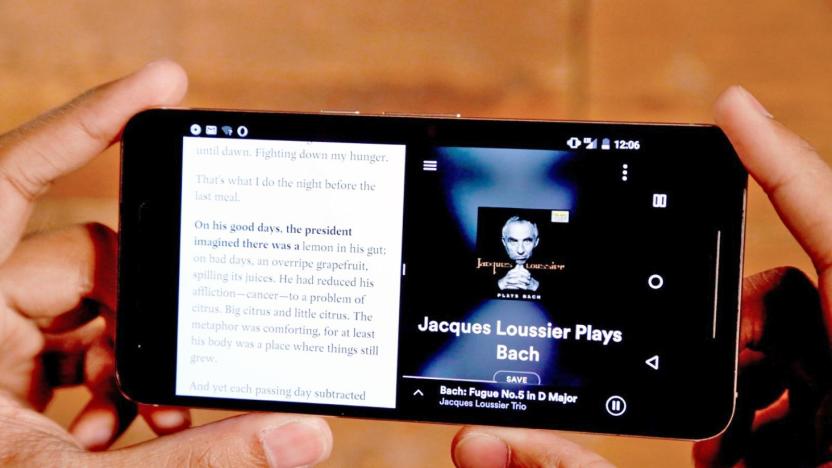universityofwaterloo
Latest

Researchers' app extends battery life when you're multitasking
Battery life on a phone is bad enough most of the time, but it can be particularly rough if you're fond of split-screen multitasking. Researchers might have a way to wring a little more power out of your device, however. They've developed an app, MultiDroid, that promises to extend battery life on Android phones with OLED screens. The software dynamically lowers the brightness in non-critical parts of the screen depending on how you switch between apps and how long you've left a section idle. Fire up a YouTube video on one half of your screen, for example, and the browser you've left idle in the other half will grow darker.

'Astrocyte' explores how architecture can interact with humans
Philip Beesley's Astrocyte aims to show that architecture can be more than just ornamental. Built from acrylic, mylar, sensors, custom glasswork, 3D-printed lights and using AI, chemistry and a responsive soundscape, it not only invokes emotional reactions but reacts to participants' movements and gestures. The giant, delicate-looking structure (inspired by astrocyte nerve cells), also prompts unusually respectful interactions from human observers.

Researchers think algorithms can improve your trash selfies
Whether we take selfies to match our own perception of what we think we look like or trying to understand how others perceive us, there's no doubt that the self portrait is the defining photographic trend of our time. Chances are, we could all use a little help in upping our selfie game, which is where new research and the resulting algorithm-powered smartphone app comes in. Computer scientists at the University of Waterloo in Canada asked thousands of Mechanical Turk workers to rate artificial selfies to find the best choice across three dimensions: lighting direction, face size, and face position. They had workers rate the selfies and then created an app that acts as a "director" for selfies, helping you get your best possible self-portrait. The researchers then had real people take photos with and without the app and submitted the selfies to raters from Mechanical Turk. They found a 26 percent improvement in the ratings of self-portraits taken with the app than those taken without direction.

Black hole detection is becoming much easier
It's still relatively difficult to spot black holes (after all, they trap light), but it may be relatively commonplace in the near future. An international team of researchers has developed a detection technique that should identify a more frequent 10 black holes per year. By using radio telescopes to capture multiple snapshots of gravitational microlensing events (where objects like black holes bend light), you can obtain details like distance, mass and velocity for subjects you can't easily study using visible light.

Canada's first self-driving car tests hit Ontario roads
Ontario ambitiously greenlit autonomous driving tests back in January, but nobody wanted to take the city up on its offer. This was likely due to its proximity to Michigan, where American car companies can test similar conditions without having to leave the country. But today brings good news for Canada: three groups are finally deploying the first self-driving cars in the country to Ontario's streets.

ICYMI: VR manipulation and drone delivery for 3D tissue
#fivemin-widget-blogsmith-image-919110{display:none;} .cke_show_borders #fivemin-widget-blogsmith-image-919110, #postcontentcontainer #fivemin-widget-blogsmith-image-919110{width:570px;display:block;} try{document.getElementById("fivemin-widget-blogsmith-image-919110").style.display="none";}catch(e){}Today on In Case You Missed It: Virtual reality researchers found a way to trick the brain into believing objects exist in the real world that only exist in the virtual one, by warping perception in a way you have to watch the video to believe.

Lazaridis-backed Quantum-Nano Centre opens tomorrow, aims to be a new Bell Labs
Mike Lazaridis may now have a considerably smaller role at RIM, but he's isn't exactly receding from the technology scene in the company's hometown of Waterloo, Ontario. That's no more evident than in the Mike & Ophelia Lazaridis Quantum-Nano Centre opening tomorrow on the University of Waterloo campus, a science and technology research center that not only bears his name but was built with $100 million of his money. As Lazaridis makes clear in an interview with Bloomberg, he's also not modest about his ambitions for the center, noting that it is "absolutely" going to be the Bell Labs of the 21st century. Or, perhaps more specifically, a Bell Labs for quantum computing and nanotechnology, areas of research that Lazaridis says are key in order to "break through those barriers" of traditional computing. You can find the full interview and more details on the center itself at the links below.

Telex anti-censorship system promises to leap over firewalls without getting burned
Human rights activists and free speech advocates have every reason to worry about the future of an open and uncensored internet, but researchers from the University of Michigan and the University of Waterloo have come up with a new tool that may help put their fears to rest. Their system, called Telex, proposes to circumvent government censors by using some clever cryptographic techniques. Unlike similar schemes, which typically require users to deploy secret IP addresses and encryption keys, Telex would only ask that they download a piece of software. With the program onboard, users in firewalled countries would then be able to visit blacklisted sites by establishing a decoy connection to any unblocked address. The software would automatically recognize this connection as a Telex request and tag it with a secret code visible only to participating ISPs, which could then divert these requests to banned sites. By essentially creating a proxy server without an IP address, the concept could make verboten connections more difficult to trace, but it would still rely upon the cooperation of many ISPs stationed outside the country in question -- which could pose a significant obstacle to its realization. At this point, Telex is still in a proof-of-concept phase, but you can find out more in the full press release, after the break.

Students build self-balancing TIPI robot, plan new world order (video)
Remember this guy, the QB robot that was priced at a whopping 15 grand? Seemingly, the webcam wheeler inspired a team of young minds at the University of Waterloo, who've unleashed the DIY in themselves to build one of their own. TIPI, or Telepresence Interface by Pendulum Inversion, was designed to give humans the feeling that they're not actually talking to a six-foot tall cyclops cyborg with an LCD face and webcam eye, but rather, evoke the emotions drawn when speaking the old, conventional, face-to-face way. Thanks to this team of mechatronics engineers, the low-cost TIPI uses an accelerometer, gyro and pendulum to balance by itself and can be remotely controlled while communicating via its Beagle Board and Polulu Orangutan SVP brain. Head past the break to see the robot struttin' its stuff -- oh, and get ready to rave. You'll see what we mean.

CRISTAL combines 'The Sims' and Surface for full room control
Have you ever yearned for more immediate control over your surroundings? No, we don't mean Magneto car-flipping abilities. We mean more like wrangling all of the gear in a room into some kind of understandable and connected system. If you said yes -- and you're a Sims aficionado -- you'll want to check into CRISTAL. We're not talking expensive champagne here, we're talking about the "Control of Remotely Interfaced Systems using Touch-based Actions in Living spaces" system (c'mon, it sort of makes sense). The premise is simple: instead of having to juggle multiple remotes and input systems to deal with a room full of technology, CRISTAL merges a Surface-like touch area (your coffee table in this scenario), an overhead camera, and connected devices to form a frighteningly intuitive control scheme. The idea allows for all sorts of handy arrangements, like being able to virtually drag media from a server on one side of the room to your TV on the other, dim lights in a particular area by swiping on that location, or draw a path for a Roomba to clean using the overhead view. Right now this is just a research project, of course, but the team working on the concept believes costs could move down from the astronomic $10,000-$15,000 the setup would cost now to a more affordable range. Until that happens, you'll have the video of CRISTAL in action after the break.

Researchers develop laser-guided microhoverbot, Engadget coins new word
We could have sworn that one of our commenters had already invented this, but maybe not. Researchers at the University of Waterloo in Ontario -- led by Professor Mir Behrad Khamesee -- has developed a microbot weighing in at about three-hundredths of an ounce that hovers and moves about on a three dimensional parabolic magnetic field. Altering the flow of the electromagnetic current distorts the field and propels the robot. Additionally, the device has pincers that open when heated by a laser, closing once they're allowed to cool. The device is monitored by laser sensors and by camera, and since the it floats free of any sort of wiring (and power is supplied from outside the robot) it is ideal for working in clean rooms or hazardous environments. Not too shabby, eh? At the very least, we got to use the word "microhoverbot."[Via CNet]

Motorized SnoDeck shreds through the snow
You may have a hard time pulling off an ollie with it, but this so-called SnoDeck developed by a group of students at the University of Waterloo looks like it could at least provide a suitable alternative to snowboarding for those that don't feel like trekking up a hill all the time. Relying on some electric drill motors to move it along, the deck apparently has a turning radius of two meters, and a kill switch to prevent it from taking out by-standers when the rider falls off. Of course, this being a student project you'll have to be content with admiring it from afar for the time being, which you can do by hitting up the video after the break.[Via MAKE:Blog]






